| Article ID | Journal | Published Year | Pages | File Type |
|---|---|---|---|---|
| 1575695 | Materials Science and Engineering: A | 2014 | 10 Pages |
Abstract
The evolution of lattice strains in a fully recrystallised Fe-24Mn-3Al-2Si-1Ni-0.06C TWinning Induced Plasticity (TWIP) steel subjected to uniaxial tensile loading up to a true strain of ~35% was investigated via in-situ neutron diffraction. Typical of fcc elastic and plastic anisotropy, the {111} and {200} grain families record the lowest and highest lattice strains, respectively. Using modelling cases with and without latent hardening, the recently extended Elasto-Plastic Self-Consistent model successfully predicted the macroscopic stress-strain response, the evolution of lattice strains and the development of crystallographic texture. Compared to the isotropic hardening case, latent hardening did not have a significant effect on lattice strains and returned a relatively faster development of a stronger ã111ã and a weaker ã100ã double fibre parallel to the tensile axis. Close correspondence between the experimental lattice strains and those predicted using particular orientations embedded within a random aggregate was obtained. The result suggests that the exact orientations of the surrounding aggregate have a weak influence on the lattice strain evolution.
Related Topics
Physical Sciences and Engineering
Materials Science
Materials Science (General)
Authors
Ahmed A. Saleh, Elena V. Pereloma, Bjørn Clausen, Donald W. Brown, Carlos N. Tomé, Azdiar A. Gazder,
